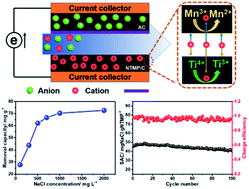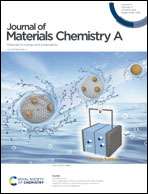Enabling superior hybrid capacitive deionization performance in NASICON-structured Na3MnTi(PO4)3/C by incorporating a two-species redox reaction†
Abstract
Capacitive deionization (CDI) is a robust water treatment technique due to its energy-efficient, low cost, and environmentally safe features. Recently, the utilization of faradaic electrode materials to construct hybrid capacitive deionization (HCDI) is considered to be one of the effective ways to address the drawbacks of the inferior desalination capacity of conventional CDI. Here, for the first time, a Na3MnTi(PO4)3/C (NTMP/C) composite was prepared via a sol–gel-calcination method and used as a faradaic electrode in HCDI. The NTMP nanoparticles were encapsulated in a carbon matrix, which could reduce the ion diffusion distance as well as ensure rapid ion transmission. In addition, taking the advantage of the high ratio of pseudo-capacitive performance and the two-species redox reaction of Ti4+/Ti3+ and Mn3+/Mn2+ couples, the obtained NTMP/C composite displayed a large ion removal capacity (72.2 mg g−1) (IRC), ultrafast ion removal rate (IRR) (21.6 mg g−1 min−1) and excellent cycle stability. Moreover, the mechanism of the Na+ removal of NTMP/C in the desalination process was investigated via electrochemical and ex situ structural characterization. This study indicates that NTMP/C can be an alternative faradaic electrode material towards CDI applications.

- This article is part of the themed collection: Journal of Materials Chemistry A HOT Papers


 Please wait while we load your content...
Please wait while we load your content...